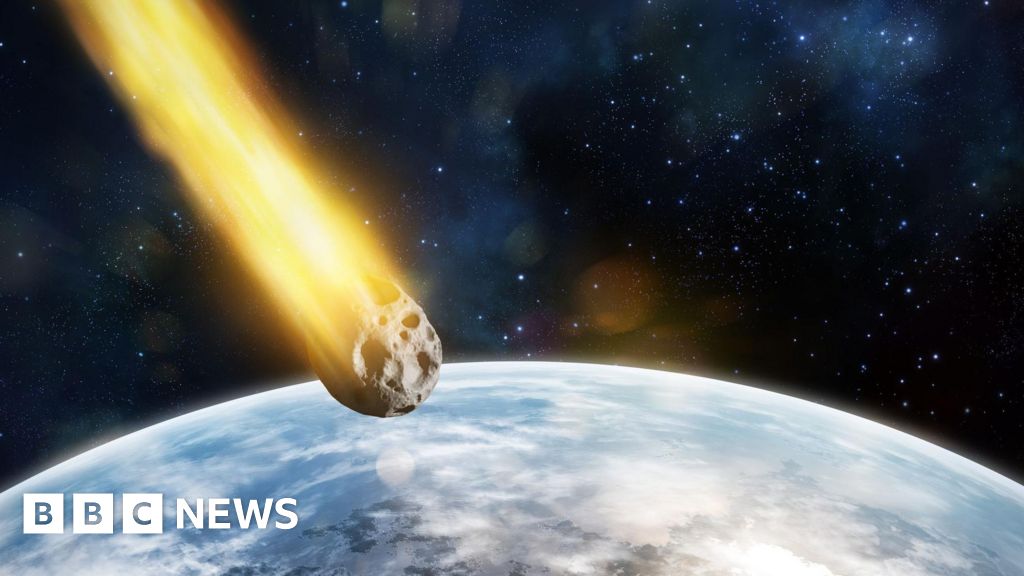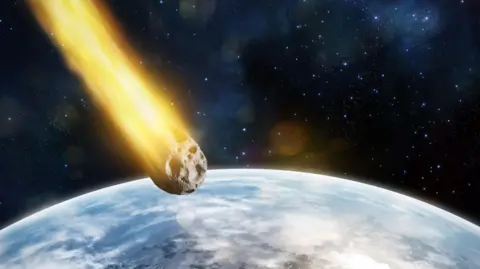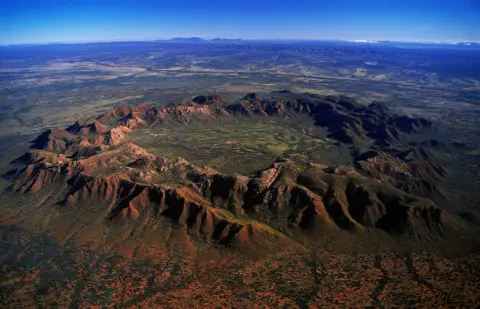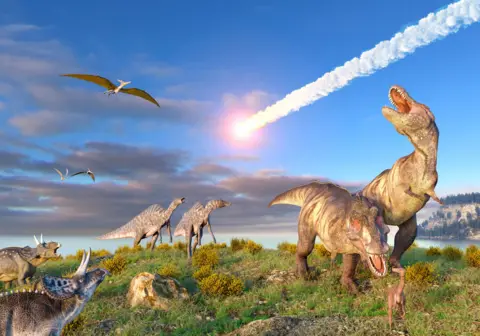Nadir crater: The asteroid that killed the dinosaurs was not alone

 Getty Images
Getty ImagesThe huge asteroid that hit Earth and wiped out the dinosaurs 66 million years ago was not alone, scientists have confirmed.
A second, smaller space rock smashed into the sea off the coast of West Africa creating a large crater during the same era.
It would have been a “catastrophic event”, the scientists say, causing a tsunami at least 800m high to tear across the Atlantic ocean.
Dr Uisdean Nicholson from Heriot-Watt University first found the Nadir crater in 2022, but a cloud of uncertainty hung over how it was really formed.
Now Dr Nicholson and his colleagues are sure that the 9km depression was caused by an asteroid hurtling into the seabed.
They cannot date the event exactly, or say whether it came before or after the asteroid which left the 180km-wide Chicxulub crater in Mexico. That one ended the reign of the dinosaurs.
But they say the smaller rock also came at the end of the Cretaceous period when they went extinct. As it crashed into Earth’s atmosphere, it would have formed a fireball.
“Imagine the asteroid was hitting Glasgow and you’re in Edinburgh, around 50 km away. The fireball would be about 24 times the size of the Sun in the sky – enough to set trees and plants on fire in Edinburgh,” Dr Nicholson says.
 Getty Images
Getty ImagesAn extremely loud air blast would have followed, before seismic shaking about the size of a magnitude 7 earthquake.
Huge amounts of water probably left the seabed, and later cascaded back down creating unique imprints on the floor.
It is unusual for such large asteroids to crash out of our solar system on course for our planet within a short time of each other.
But the researchers don’t know why two hit Earth close together.
 Getty Images
Getty ImagesThe asteroid that created the Nadir crater measured around 450-500m wide, and scientists think it hit Earth at about 72,000km/h.
The nearest humans have come to this scale of event was the Tunguska event in 1908 when a 50-metre asteroid exploded in the skies above Siberia.
The Nadir asteroid was about the size of Bennu, which is currently the most hazardous object orbiting near Earth.
Scientists say the most probable date that Bennu could hit Earth is 24 September 2182, according to Nasa. But it is still just a probability of 1 in 2,700.
There has never been an asteroid impact of this size in human history, and scientists normally have to study eroded craters on Earth or images of craters on other planets.
To further understand the Nadir crater, Dr Nicholson and team analysed high-resolution 3D data from a geophysical company called TGS.
Most craters are eroded but this one was well-preserved, meaning the scientists could look further into the rock levels.
“This is the first time that we’ve ever been able to see inside an impact crater like this – it’s really exciting,” says Dr Nicholson, adding there are just 20 marine craters in the world but none have been studied in detail like this.
The findings are reported in Nature Communications Earth & Environment.
Related
Youth football teams hold minute’s silence for 10-year-old Poppy Atkinson
Youth football teams and grassroots clubs across the country have held a minute’s silence at the start of their games to commemorate a 10-year-old girl who di
Girl’s death sparks minute’s silence at football matches nationwide
10-year-old Poppy Atkinson was killed when she was struck by a car during a training session at Kendal Rugby Club in Cumbria. Clubs from Leeds to London
Liverpool fans’ Uefa claim can be heard in England, judge…
The high court, sitting in Liverpool, heard Uefa had relied upon the principle that English courts will not inquire into the legality of actions by foreign gove
Alan Shearer’s Premier League predictions including Manchester United vs Arsenal
Caption: Alan Shearer?s Premier League predictions credit: Getty / Metro After some impressive results for English sides in Europe the focus is













